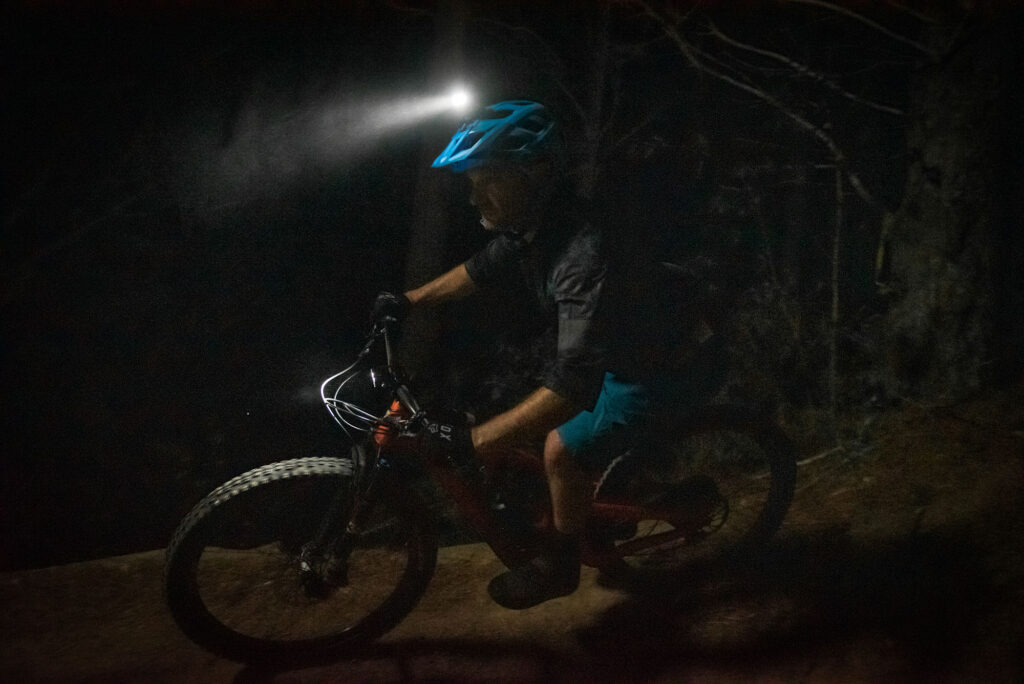Mountain biking at night is an exhilarating experience that offers a new dimension to your riding adventures. However, it also comes with its own set of challenges, the most significant being visibility. Adequate lighting is not just a convenience; it’s a necessity for safety and performance.
As you navigate through technical trails, your ability to see and react to the terrain ahead depends largely on the quality of your light, particularly its beam pattern. So let’s take a look at the different beam patterns for lights used in mountain biking at night, exploring their characteristics and optimal uses.
Understanding beam patterns
The beam pattern of a light refers to how it distributes light over an area. In the context of mountain biking, the most common beam patterns are spot, flood, and a combination of both. Each pattern has its unique advantages, making it suitable for specific trail conditions and biking styles.
Spot beam pattern
Spot beams, also known as focused or narrow beams, concentrate light into a smaller, more defined area. This pattern allows riders to see further down the trail, making it ideal for high-speed riding or navigating technical sections where anticipating obstacles in advance is crucial. The concentrated light pierces through darkness, providing clarity and depth perception over long distances. However, its narrower focus can make it challenging to perceive wider trail surroundings, which is essential for adjusting to immediate terrain changes.

Flood beam pattern
In contrast, flood beams, sometimes referred to as wide beams, disperse light over a broader area but with less distance penetration. This pattern illuminates a wide swath of the trail and its peripheries, enhancing peripheral vision and helping riders better understand the terrain’s immediate contours and potential hazards. Flood beams are particularly useful for twisty trails, slow to moderate speeds, or technical sections requiring precise maneuvering. The downside is their limited reach, which can reduce the ability to see far ahead.

Dual or combination beam pattern
To harness the benefits of both spot and flood beams, many mountain biking lights, including our Gloworm range, offer a dual or combination beam pattern. These lights integrate both focused and wide beams into a single unit, providing the versatility to adapt to varying trail conditions and speeds. Riders can switch between the patterns based on their immediate needs, ensuring optimal visibility whether tackling fast descents, technical climbs, or twisty singletracks. Combination beams represent a balanced approach, offering a compromise between distance vision and peripheral awareness.

Selecting the right beam pattern for your ride
Choosing the right beam pattern is pivotal to enhancing your night-time mountain biking experience. Here are some considerations to guide your selection:
Trail Type and Speed: Fast, open trails demand a spot beam to see further ahead, while technical, winding trails benefit from a flood beam for better side-to-side visibility.
Riding Style: Aggressive riders focusing on speed might prefer spot beams for their depth perception, whereas exploratory riders might value the broad visibility of flood beams.
Light Positioning: Combining different beam patterns through strategic light positioning can optimise visibility. For instance, mounting a spot beam on your helmet and a flood beam on your handlebars can provide a comprehensive lighting setup, allowing for both distance vision and immediate terrain awareness.
Choosing the right beam pattern not only enhances your visibility but also your confidence, allowing you to push your limits and explore the trails under the stars. So, gear up with Gloworm and embrace the thrill of night-time mountain biking.


